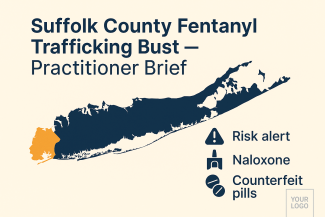Suffolk County Fentanyl Trafficking Bust: Practitioner Brief for Prevention & Treatment Teams
Benjamin Zohar, NCACIP
-

Suffolk County Fentanyl Trafficking Bust: Practitioner Brief for Prevention & Treatment Teams
Context & Reported Facts
- Authorities announced a large-scale, multi-location takedown following a months-long investigation in Suffolk County, Long Island.
- Seizures included multi-kilogram fentanyl, cocaine, cash, firearms/high-capacity magazines, ammunition and pill-pressing equipment.
- Officials characterized the bust as historically significant for the county and warned about counterfeit pills moving through local networks and social media.
Source coverage: CBS New York report on Suffolk County fentanyl bust; ABC7NY coverage of multi-location operation; NBC New York article on the seizure.
Framing note: Phrases like “enough to kill X people” are law-enforcement communications, not clinical dose-response guidance. Use toxicology and public-health data when crafting risk messages.
Why This Matters for the Field
- Potency & adulteration: Multi-kg fentanyl in suburban corridors signals broad exposure risk across opioid and stimulant markets (e.g., fentanyl in cocaine).
- Counterfeit pill vector: Pill-press activity and social distribution increase naïve exposure among non-opioid users.
- Market disruption effects: Post-seizure supply fluctuations can precede unpredictable potency on re-entry to the local market.
Practice Implications
Harm Reduction
- Scale up naloxone distribution and training; plan for multiple doses when fentanyl exposure is suspected.
- Where lawful, expand access to fentanyl test strips; teach “test-dose,” avoid using alone, and ensure someone present has naloxone.
- Issue clear alerts on counterfeit tablets (e.g., “M30”-style) sold offline/online; emphasize unknown dose variability.
Clinical & Treatment
- Screen for polysubstance exposure (fentanyl with cocaine/pressed pills); monitor for sedative adulterants where regionally relevant.
- Strengthen rapid access to MOUD (buprenorphine/methadone); enable ED warm hand-offs and same-day starts.
- Prepare for post-seizure overdose spikes: tighten follow-up scheduling, proactive check-ins, and linkage to ongoing care.
Community Coordination
- Unify messaging among health departments, ISSUP affiliates, SUD treatment providers, schools, and harm-reduction groups.
- Refresh and circulate local resource maps (naloxone pick-up points, low-barrier clinics, peer recovery support).
Recommended Public Messages (Template)
- “Local supplies may contain high-potency fentanyl or fentanyl-laced pills. Use with caution; never use alone.”
- “Carry naloxone and know how to use it; multiple doses may be required.”
- “Free naloxone/training: [Insert local links]. Low-barrier treatment: [Insert hotline/clinic links].”
Further Reading
- CBS New York: Suffolk County fentanyl bust
- ABC7NY: Large-scale drug operation in Suffolk County
- NBC New York: Suffolk fentanyl seizure details
Disclaimer: This content is for professional education. It is not legal, clinical, or toxicology advice.
Benjamin Zohar, NCACIP — ISSUP member focusing on intervention services and community education. Author profile
Last reviewed: 8 November 2025